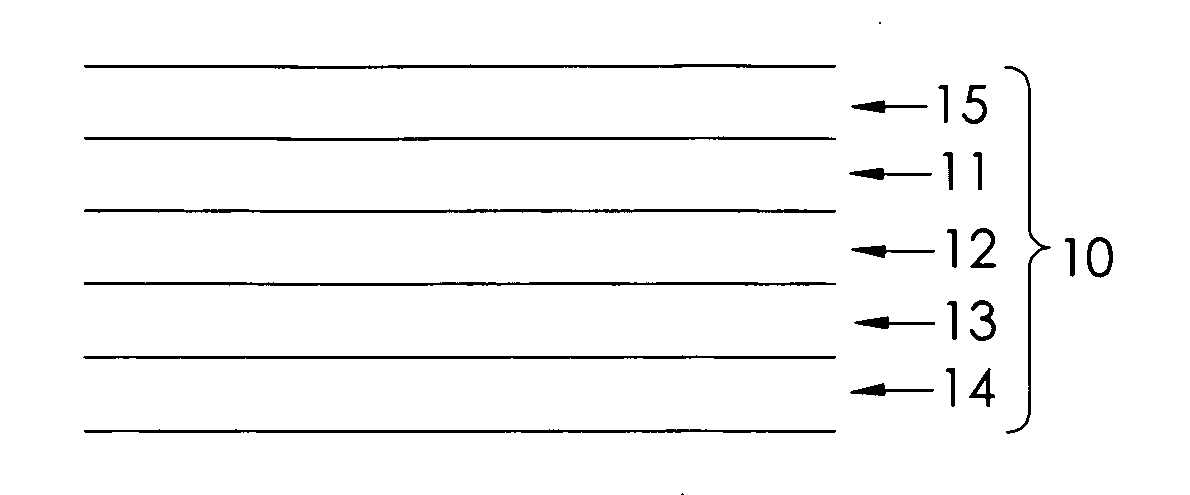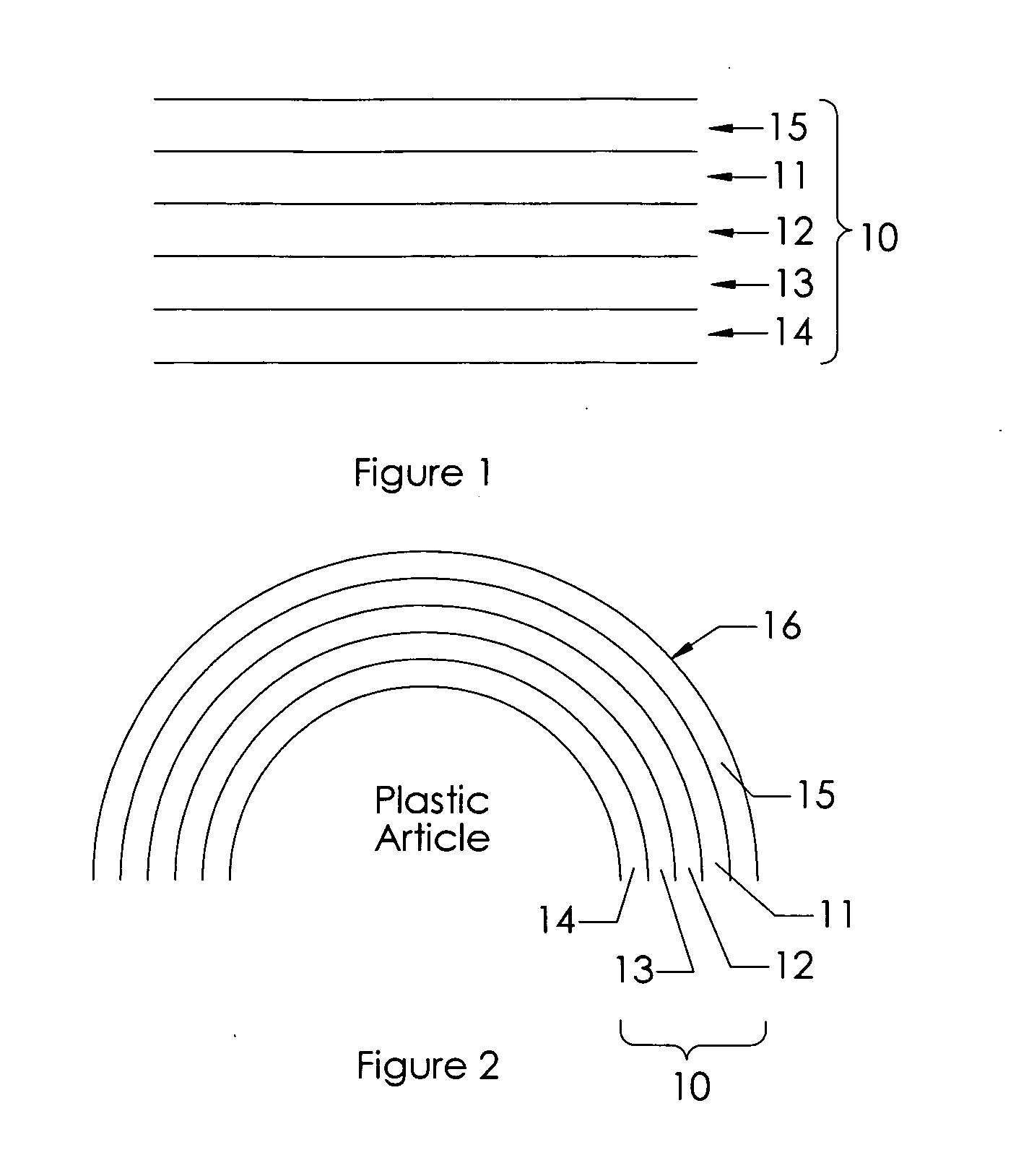Adhesive layer composition for in-mold decoration
a technology of in-mold decoration and composition, which is applied in the direction of film/foil adhesives without carriers, film/foil adhesives, other domestic articles, etc., can solve the problems of contamination of the production environment, inability to cleanly separate the durable layer from the release layer, and the current availability of decoration tape or strip, etc., to achieve high transmission, high blocking resistance, and efficient propagation
- Summary
- Abstract
- Description
- Claims
- Application Information
AI Technical Summary
Benefits of technology
Problems solved by technology
Method used
Image
Examples
example 1
[0065] A release fluid was prepared first by mixing 2.10 gm of MF370 (methylated melamine resin, Cytec Industries) with 1.41 gm of ethylene glycol dimethyl ether (Aldrich) and 0.63 gm of DI water using a magnetic stirrer, after which 0.6 gm of 2,2′-dihydroxy-4-methoxybenzophenone (Aldrich), 0.06 gm of Silwet L7230 / SL7607 (3 / 1 weight ratio, from Osi Specialties, Inc.) and 0.2 gm of Cycat 4040 (p-toluene sulfonic acid, from Cytec Industry) were added with agitation to ensure a homogeneous solution. This release fluid was then coated on a 1.5 mil PET film (PT1 from Mitsubishi Interfilm Holding, Inc., Easley, S.C.) with a #6.5 rod and a target dry coating thickness of 1.5 um. The coating was then placed in a 120° C. oven for 5 minutes to form a release coating.
[0066] A durable layer composition consisting of 7.67 gm (15% in MEK) of CAB-553-0.4 (cellulose acetate butyrate, from Eastman Chemical Co.), 2.94 gm (50% in MEK) of Ebecryl 1290 (aliphatic polyurethane acrylate, UCB Chemicals), ...
example 2
Comparative Example
[0071] 8.154 Grams of AquaPress ME and 7.74 gm of DI water were mixed together. The resulting mixture was coated onto the durable layer prepared in Example 1 and dried in an 80° C. oven for 10 minutes. The film sample was then tested using a direct injection molding method with PMMA resin ZKM (from CYRO Industries) at 480° F.
TABLE 1Trans-Film Blocking atAd-Lens Edgeparency of40° C. / 90%hesionCleannessthe LensRH & 60 HoursExample 1goodexcellentexcellentpassExample 2good90% filmexcellentfail(Comparativeremaining withExample)the lens
examples 3-5
The Use of Organic Particles with Different Tgs
[0072] In these examples, the pH values of all the materials used were pre-adjusted to 8.5 prior to mixing.
[0073] 1.303 Grams of S-2725 (water borne polyurethane) of a 19% solid content (from Neveon), 4.523 gm of AquaPress ME of a 39% solid content (from Proell Inc) and 7.0 gm of DI water were mixed together. To this mixture, 0.84 gm of S-50 (silica nanoparticles) of a solid content of 29% (from Nissan Chemical Houston Corporation) was added, followed by adding 1.15 gm of B-85 (non-crosslinking acrylic emulsion) of a 31.3% solid content (Tg=73° C., Rohm & Haas) with agitation (in Example 3). In Example 4, 1.125 gm of NeoCryl A-6015 (acrylic emulsion) of a 32% solid content (Tg=63° C., NeoResins) was added. In Example 5, 0.818 gm of CL-106 (acrylic resin) of a 44% solid content (Tg=46° C., Rohm & Haas) was added. An additional 0.184 gm, 0.209 gm and 0.516 gm of water were added into Formulations of Example 3, Example 4 and Example 5, r...
PUM
| Property | Measurement | Unit |
|---|---|---|
| Fraction | aaaaa | aaaaa |
| Percent by mass | aaaaa | aaaaa |
| Percent by mass | aaaaa | aaaaa |
Abstract
Description
Claims
Application Information
 Login to View More
Login to View More - R&D
- Intellectual Property
- Life Sciences
- Materials
- Tech Scout
- Unparalleled Data Quality
- Higher Quality Content
- 60% Fewer Hallucinations
Browse by: Latest US Patents, China's latest patents, Technical Efficacy Thesaurus, Application Domain, Technology Topic, Popular Technical Reports.
© 2025 PatSnap. All rights reserved.Legal|Privacy policy|Modern Slavery Act Transparency Statement|Sitemap|About US| Contact US: help@patsnap.com


